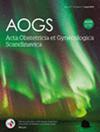The relationship between crowding in the delivery ward and the risk of postpartum hemorrhage
Abstract
Introduction
Postpartum hemorrhage (PPH) is a key concern in maternal health, with early identification important for preventing severe complications. In a crowded delivery ward, where the number of births exceeds the normal range, labor management, and PPH prevention may be compromised. Although previous research has mainly focused on crowding over the entire day, it remains unclear whether crowding in the hours surrounding birth influences PPH risk. Therefore, our study aimed to assess the association between delivery ward crowding, adjacent to birth, and PPH and to explore whether births during periods of potentially lower staffing, such as summer months or weekends, could amplify this risk.
Material and methods
This case-control study included 1 027 620 births in Sweden (2004–2019) from the Medical Birth Register. PPH, defined as estimated blood loss >1000 mL, cases were identified using a diagnostic code for PPH and were matched (1:10) with controls by the standardization criteria: delivery ward, year, and time of birth (night/day). The secondary outcome was PPH with blood transfusion. After standardization, crowding was defined as the number of births in a ±2-h interval around the index birth exceeding the 75th percentile. Unadjusted conditional logistic regression was used to study the association between crowding and PPH, PPH with blood transfusion, and to examine whether giving birth during a weekend or summer vacation month (June–August) modified these associations. Results were presented as odds ratios (OR) with 95% confidence intervals (CI).
Results
Labor induction and emergency cesarean delivery were less common in births that occurred during crowded compared to noncrowded time intervals. Crowding was not associated with an increased risk of PPH (OR: 0.97; 95% CI: 0.95–0.99) or PPH with blood transfusion (OR: 0.99; 95% CI: 0.92–1.07). Giving birth during a summer month or a weekend did not change the estimates for the association between crowding and PPH.
Conclusions
Focusing on a narrow time frame around birth, crowding in the delivery ward was not associated with an increased, but instead a modest reduction, in risk of PPH. Future studies should investigate how staffing in relation to crowding influences the risk of PPH and other adverse birth outcomes.


 求助内容:
求助内容: 应助结果提醒方式:
应助结果提醒方式:


